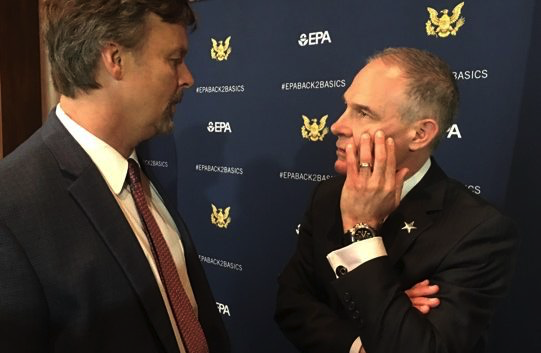 EPA will stop relying on “secret science” in its rule-making process and enter a new era of transparency under a new regulation Administrator Pruitt unveiled at EPA headquarters.
EPA will stop relying on “secret science” in its rule-making process and enter a new era of transparency under a new regulation Administrator Pruitt unveiled at EPA headquarters.
“In a long overdue action, EPA Administrator Scott Pruitt has proposed to end his agency’s decades-long practice of using secretive, questionable, even deceptive or fraudulent science to support policy and regulatory initiatives,” writes Paul Driessen. “Pruitt’s changes will help ensure that any science underlying agency actions is transparent and publicly available, so that independent experts can examine it and determine whether it passes basic tests for sound, accurate, honest science.”
“Predictably, various politicians, environmental activists, government-funded scientists and journalists have railed against the proposal. This article presents examples of past EPA junk science, discusses why the critics are misinformed and underscores why these reforms should be implemented immediately.”
More:
Environmental Protection Agency Administrator Scott Pruitt has proposed to end the longstanding EPA practice of using secretive, often questionable, even deceptive science to support agency policy and regulatory initiatives. His proposed rules will ensure that any science underlying agency actions is transparent and publicly available for independent experts to examine and validate – or point out its flaws.
It also responds to growing concerns that extensive scientific research in environmental, medical and other arenas cannot be replicated by other scientists, or is compromised by cherry-picked data, poor research design, sloppy analysis or biased researchers. The situation has led to calls for increased sharing of data and methodologies, more independent peer review and other actions to weed out problems. There is no excuse for hiding data when studies are funded by taxpayers or used to justify regulations.
The situation has been especially acute at EPA. As Mr. Pruitt observed, “The ability to test, authenticate and reproduce scientific findings is vital for the integrity of the rule making process. Americans deserve to assess the legitimacy of the science underpinning EPA decisions that may impact their lives.”
That is particularly true for regulations that exact millions or billions in compliance costs, affect thousands of jobs, target industries and coal-fired electricity generators that regulators want to close down, or seek to replace all fossil fuel use with “renewable” energy. With the cumulative economic impact of federal regulations reaching nearly $2 trillion per year, research reform is absolutely essential.
We need regulation and pollution control – but it must be based on solid, replicable, honest science.
Congressman Lamar Smith (R-TX) has held hearings and championed multiple bills to address the problem. Several have been passed by the House of Representatives, only to languish in the Senate. With courts offering little or no help, Executive Branch action may be the only remaining solution.
Deceptive, faulty science on fine particulate pollution (PM2.5) was the bedrock of the Obama EPA’s war on coal. Particulates don’t just make you sick; they are directly related “to dying sooner than you should,” EPA Administrator Lisa Jackson falsely told Congress. There is no level “at which premature mortality effects do not occur,” Mr. Obama’s next Administrator Gina McCarthy dishonestly testified.
At the same time they made these claims, they were presiding over illegal experiments on humans – including people with asthma, diabetes and heart disease – who were subjected to eight, 30 or even 60 times more particulates per volume, for up to two hours, than what EPA claimed are dangerous or lethal. None of them got sick, proving that EPA’s claims were false. The agency refused to correct its claims.
EPA took a similar stance on mercury – asserting that power plant emissions were causing dangerously high mercury levels in American children and pregnant women. In reality, US power plants account for just 0.5% of all the mercury in the air Americans breathe, and blood mercury counts for US women and children are well below even EPA’s excessively safe levels, according to the Centers for Disease Control.
How did EPA’s junk science, illegal experiments and heavy-handed regulations pass muster? For one thing, politics too often dictated the science. In addition, the agency paid more than $180 million over a 16-year period to institutions represented by members of its Clean Air Scientific Advisory Committee (CASAC), which often rubberstamped studies and conclusions that failed integrity and transparency tests.
On global warming, EPA issued an Endangerment Finding, which claimed emissions of (plant-fertilizing) carbon dioxide from burning fossil fuels threatened the health and welfare of American citizens.
It reached this conclusion by looking only at studies and computer models from the Intergovernmental Panel on Climate Change, while ignoring volumes of studies by independent scientists who found no such threat. EPA officials even told one of the agency’s own senior experts that his studies would not be shared with agency staff and he was to cease any further work on climate change, because his analyses “do not help the legal or policy case for this decision” that fossil fuel CO2 emissions endanger Americans.
EPA was also a principal force behind the “social cost of carbon” scheme that supposedly calculated how much CO2-driven climate change would cost the United States and how those costs would be reduced by slashing fossil fuel use. The alleged cost of damages began at an arbitrary $22 per ton of carbon dioxide released in 2010, then climbed to an equally random $30 per ton in 2013 and $40 per ton in 2016.
Incredibly, EPA modelers also claimed they can accurately forecast global temperatures, climate and weather, technological advances, economic development, living standards – and damages to global civilizations and ecosystems from US carbon dioxide emissions – for the next 300 years! Moreover, in the real world, the benefits of using carbon-based fuels and improving crop, forest and grassland growth via higher atmospheric CO2 levels outweigh hypothesized costs by at least 50-to-1 to as much as 500-to-1.